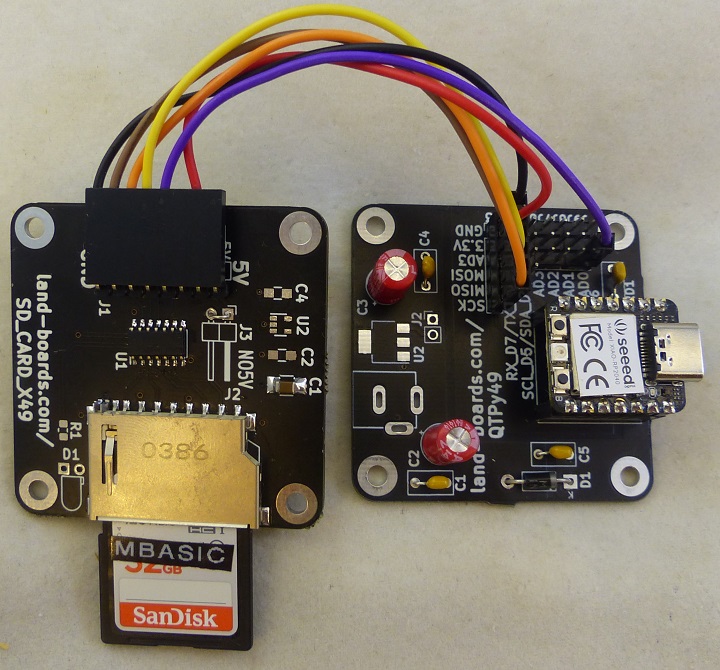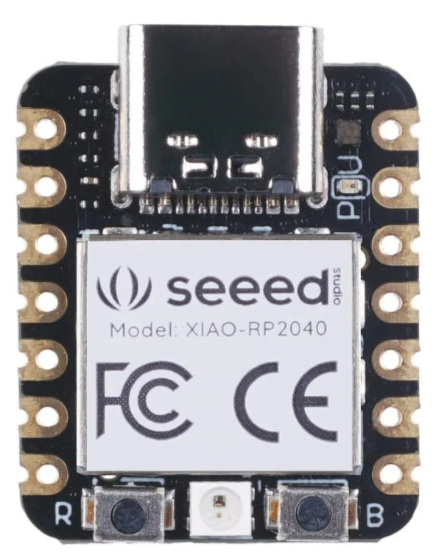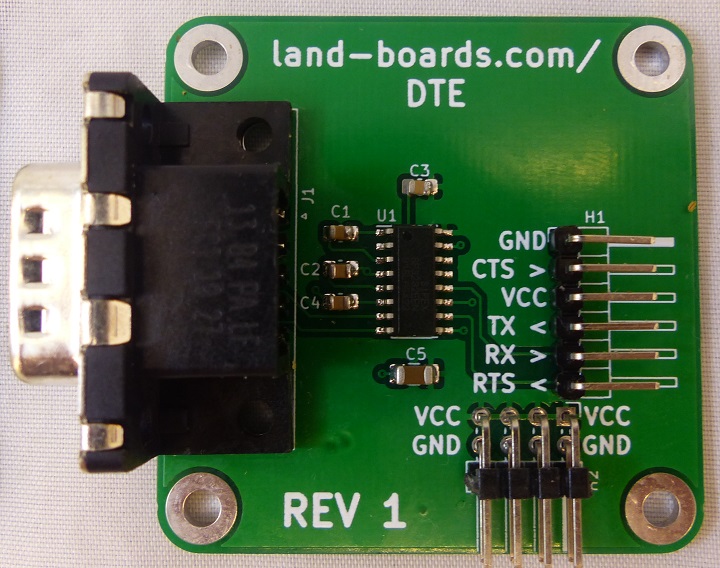Difference between revisions of "MMBASIC on XIAO RP2040"
Jump to navigation
Jump to search
Blwikiadmin (talk | contribs) |
Blwikiadmin (talk | contribs) |
||
| Line 51: | Line 51: | ||
=== QTPy49 breakout card === | === QTPy49 breakout card === | ||
| − | [[ | + | [[file:QTPy49_P18254-720px.jpg]] |
| − | [[ | + | [[QTPy49]] Wiki page |
| + | |||
| + | * CPU choices are | ||
| + | ** [[QT Py (SAMD based)]] | ||
| + | *** [https://www.adafruit.com/product/4600 Adafruit QT Py SAMD21 Product Page] | ||
| + | *** [https://www.seeedstudio.com/Seeeduino-XIAO-Arduino-Microcontroller-SAMD21-Cortex-M0+-p-4426.html?queryID=3273c05f7923d5ee5cbc677ce4892180&objectID=4426&indexName=bazaar_retailer_products Seeeduino XIAO] | ||
| + | *** 48 MHz | ||
| + | ** [[QT Py (RP2040 based)]] | ||
| + | *** [https://www.adafruit.com/product/4900 Adafruit QT Py RP2040 Product page] | ||
| + | *** [https://www.seeedstudio.com/XIAO-RP2040-v1-0-p-5026.html Seeed XIAO RP2040 Product page] | ||
| + | *** 133 MHz | ||
| + | ** [[XIAO ESP32C3]] | ||
| + | *** [https://www.seeedstudio.com/Seeed-XIAO-ESP32C3-p-5431.html?utm_source=mailchimp&utm_medium=edm&utm_campaign=bazaar_0707&ct=t%28%29&mc_cid=3303ccf0f9&mc_eid=e1825627f2 SeeedStudio XIAO ESP32C3] (New 2022-07) | ||
| + | *** RISC-V Single Core | ||
| + | *** Up to 160 MHz | ||
| + | *** 400 KB SRAM | ||
| + | *** 4 MB Flash | ||
| + | *** 2.4GHz Wi-Fi subsystem | ||
| + | *** [https://wiki.seeedstudio.com/XIAO_ESP32C3_Getting_Started/ Wiki] | ||
| + | *** [https://files.seeedstudio.com/wiki/Seeed-Studio-XIAO-ESP32/esp32-c3_datasheet.pdf?ct=t()&mc_cid=87cf985ac5&mc_eid=1dd4876369 ESP32C3 Datasheet] | ||
| + | * Connectors/Headers | ||
| + | ** DC Power | ||
| + | ** AD0 GVS | ||
| + | ** AD1 GVS | ||
| + | ** AD2 GVS | ||
| + | ** AD3 GVS | ||
| + | ** I2C with ground/VCC | ||
| + | ** TX/RX with ground/VCC | ||
| + | ** SPI with ground/VCC | ||
| + | * QTPy49 can be powered from with either the USB C or DC jack | ||
| + | ** Automatic Schottky diode power switching between | ||
| + | *** 5V from USB C | ||
| + | *** 5V on external DC jack | ||
| + | *** 7-12V on DC jack | ||
| + | * 49x49mm ODAS form factor | ||
| + | * (4) 4-40 mounting holes | ||
=== SD Card === | === SD Card === | ||
Revision as of 14:15, 20 July 2022
Contents
Overview
- Card set running BASIC Interpreter for the Raspberry Pi Pico on Seeed Studio XIAO RP2040
- MMBasic is a Microsoft BASIC compatible implementation of the BASIC language with floating point, integer and string variables, arrays, long variable names, a built in program editor and many other features
- 8 Flash locations for storage.
- Support for SD Card
MMBASIC Credits
Peter Mather led the project, ported the MMBasic interpreter to the Raspberry Pi Pico and wrote the hardware device drivers. Geoff Graham wrote the MMBasic interpreter and the manual. Mick Ames wrote the PIO compiler and its corresponding documentation.
Hardware
Seeed Studio XIAO RP2040
QT_Py_(RP2040_based) Wiki page
- Two manufacturers
- USB Type C connector
- RP2040 32-bit Cortex M0+ dual-core
- Runs at ~125 MHz
- 264 KB RAM
- SPI FLASH chip for storing files and CircuitPython/MicroPython code storage
- 8 MB - Adafruit
- 2 MB - Seeedstudio
- No EEPROM
- Can be used with C/C++ (Arduino), MicroPython, or CircuitPython
- Built-in RGB NeoPixel LED
- 13 GPIO pins (11 breakout pads and two QT pads):
- Four 12 bit ADCs (one more than Pico)
- I2C port
- 2 I2C: 1 on QT pins, one on the (Adafruit) breakout pads - Adafruit
- 1 I2C on XAIO
- SPI and UART peripherals, in standard QT Py locations,
- PWM outputs on every IO pin - for servos, LEDs, etc
- There are 6 GPIO in consecutive order for PIO compatibility
- 3.3V logic and power 600 mA
- Both Reset button and Bootloader select buttons for quick restarts (no unplugging-replugging to relaunch code)
QTPy49 breakout card
QTPy49 Wiki page
- CPU choices are
- QT Py (SAMD based)
- QT Py (RP2040 based)
- XIAO ESP32C3
- SeeedStudio XIAO ESP32C3 (New 2022-07)
- RISC-V Single Core
- Up to 160 MHz
- 400 KB SRAM
- 4 MB Flash
- 2.4GHz Wi-Fi subsystem
- Wiki
- ESP32C3 Datasheet
- Connectors/Headers
- DC Power
- AD0 GVS
- AD1 GVS
- AD2 GVS
- AD3 GVS
- I2C with ground/VCC
- TX/RX with ground/VCC
- SPI with ground/VCC
- QTPy49 can be powered from with either the USB C or DC jack
- Automatic Schottky diode power switching between
- 5V from USB C
- 5V on external DC jack
- 7-12V on DC jack
- Automatic Schottky diode power switching between
- 49x49mm ODAS form factor
- (4) 4-40 mounting holes
SD Card
SD Card Wiring
- SD_CARD_X49 card
- NO5V jumper installed
| Signal | SD_CARD_X49 | QTPy49 conn | QTPy GP | PiPico Pin |
|---|---|---|---|---|
| SPI_SCLK | J1-3 | J3-6 | GP2 | GPIO2 |
| SPI_MOSI | J1-4 | J3-4 | GP3 | GPIO3 |
| SPI_MISO | J1-2 | J3-5 | GP4 | GPIO4 |
| SPI_SS | J1-5 | J9-3 | GP26 | GPIO26 |
| GND | J1-1 | J9-1 | GND | GND |
| VCC (3.3V) | J1-7 | J9-2 | VCC | VCC |
SD Configuration
OPTION SYSTEM SPI GP2, GP3, GP4 OPTION SDCARD GP26 OPTION COLOURCODE ON
- Verify it is working
> FILES A:/ <DIR> basic <DIR> bmps <DIR> demos <DIR> games <DIR> jpegs <DIR> lbcards <DIR> performance <DIR> wave 8 directories, 0 files
RS-232 (option)
- TTL to RS-232 converter
- Male DB-9 connector
- FTDI pinout (reversed directions to directly connect to FTDI Interface)
- 49x49mm card
- 4x 4-40 holes
- DTE card
- Command to use serial
OPTION SERIAL CONSOLE GP0, GP1
RS-232 Wiring
| DTE signal | DTE pin | QTPy GP | PiPico Pin |
|---|---|---|---|
| GND | H1-1 | GND | J4-1 |
| CTS | H1-2 | N/C | N/C |
| VCC | H1-3 | VCC | J4-2 |
| TX | H1-4 | TX_D6 | J4-3 |
| RX | H1-5 | RX_D7 | J4-4 |
| RTS | H1-6 | N/C | N/C |
MMBASIC Card Stack-up
Software
Install MMBASIC on Seeed XIAO RP2040
- Hold down the "BOOT" button
- The "B" is written on the board shown to the right
- Connect the XIAO RP2040 via USB C cable to your computer while still pressing the button
- The computer then will appear a disk driver(RP1-RP2)
- Download the PicoMite_Firmware.zip
- Drag the .uf2 file to the disk drive ("RP1-RP2")
- Card will re-boot
- Connect in TeraTerm over serial
- Free memory
> print mm.ver 5.070501 > memory Program: 0K ( 0%) Program (0 lines) 124K (100%) Free RAM: 1K ( 1%) 3 Variables 0K ( 0%) General 155K (99%) Free
GPIO from MMBASIC
| QTPy49 Marking | GPIO |
|---|---|
| A0 | GP26 (SD_SS) |
| A1 | GP27 |
| A2 | GP28 |
| A3 | GP29 |
| I2C_SDA | GP6 |
| I2C_SCL | GP7 |
| RX | GP1 |
| TX | GP0 |
MMBASIC - Using Pins
- Digital I/O
SETPIN GP27, DIN:' Digital Input SETPIN GP28, DOUT:' Digital Output PIN(GP28) = 1:'Digital output
- Analog Input
SETPIN GP29, AIN:' Analog Input
- SETPIN(s) for Serial and I2C
SETPIN GP1, GP0, COM1 SETPIN GP6, GP7 I2C2
On-Board LED
- No Built-in support in MMBASIC for the on-board NEOPIXEL
- Red, Green, Blue LED
- Pull Low to turn on RGB LED bits
- At-boot - RGB LED blinks Cyan/Green by MMBASIC
- Red LED = GP17
- Green LED = GP16
- Blue LED = GP25 (Used by MMBASIC)
' Make pins outputs SETPIN GP17, DOUT:' Red LED SETPIN GP16, DOUT:' Green LED SETPIN GP25, DOUT:' Blue LED ' Turn off LEDS PIN(GP17)=1:' Turn off Red LED PIN(GP25)=1:' Turn off Blue LED PIN(GP16)=1:' Turn off Green LED ' Turn on LEDs PIN(GP17)=0:' Turn on Red LED PIN(GP25)=0:' Turn on Blue LED PIN(GP16)=0:' Turn on Green LED
Demo Code
- SD Card contents
- PROTO16_LEDs.bas
- Bounces a bit across the PROTO16-I2C card
- PROTO16_LEDs.bas





